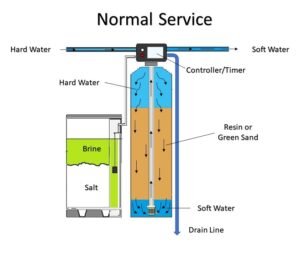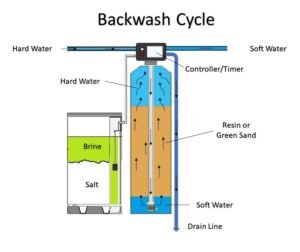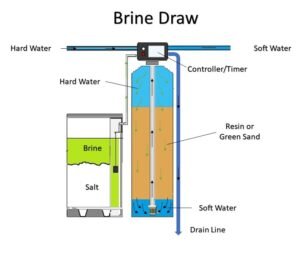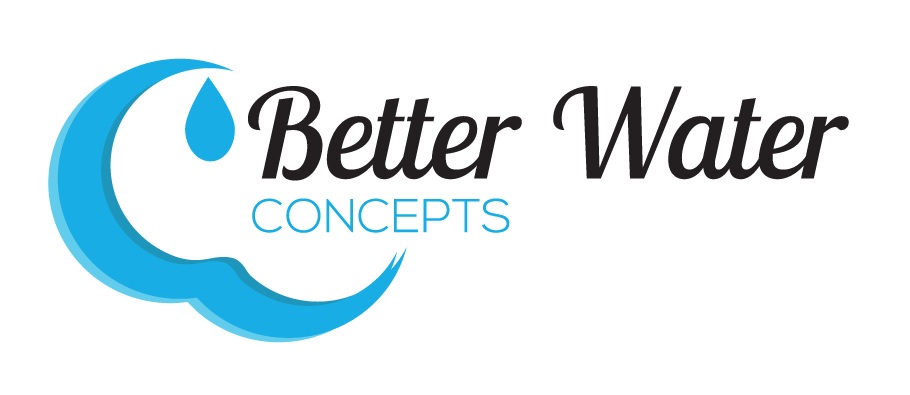We're an affiliate
We hope you love the products we recommend! Just so you know, we may collect a share of sales or other compensation from the links on this page. Thank you if you use our links, we really appreciate it!
How Does a Water Softener Work?
I am writing this blog post to inform my readers about how a water softener works. I know that many people are trying to save money and water usage, so I want to shed some light on the subject for you.
How does a water softener work? Well, it’s really quite simple! A water softener works by replacing the calcium and magnesium ions that cause hard water with sodium ions, which are less likely to cause scale buildup and other problems.
What is Hard Water?

Simply put, we often refer water hardness to as the soap consuming capacity of the water. The greater the hardness of the water, the more soap it takes to create a lather.
Hard water is the culprit that creates the white coating on the inside of pipes. In fact, hard water can deposit on any surface it comes in contact with. Hard water deposits can clog showerheads and faucets. They can also shorten the life of your water heater, dishwasher and many other appliances that use water.
What Causes The Water To Be Hard?
The main minerals that make water hard are calcium and magnesium. They exist in water as calcium carbonate, magnesium carbonate, calcium carbonate and magnesium bicarbonate.
We usually measure water hardness in two different ways.
The first is parts per million or ppm. So, one ppm of hardness is one part of hardness in one million parts of water. You may also see it listed as milligrams per liter or mg/l. One ppm is equal to one mg/l. So those two measurements are basically the same thing.
The second way hardness measured is in grains per gallon or gpg. Without a lot of math and detail about what a grain per gallon is, just know that one grain per gallon equals 17.1 ppm.
Why It Is Important To Understand The Different Hardness Measurements
Most public and private water supplies measure water hardness in ppm.
Most softener manufacturers use gpg in their calculations for hardness removal. They will refer to their softeners as able to remove x gpg per cycle.
If you know how to convert this information, you can pick the best water softener for your house.
As a simple example:
Assume a supply of water with 171 ppm hardness. To find gpg divide ppm by 17.1.
171/17.1 = 10 gpg
Now assume a water softener will remove 32,000 grains of hardness per cycle.
32,000 grains/10 gpg = 3,200 gallons of soft water processed.
A family of four with an average daily water use of 80 gallons per day per person (for 320 gallons per day). This water softener would last for 10 days for each cycle.
Here Is What A Water Softener Does
What happens in the softening process, the water passes through a filter, a bed of special resin granules called zeolite. Some people call it greensand.
The greensand is already charged with sodium. We introduce fresh, hard water. The hard water that contains calcium and magnesium.
The water passes through the greensand. The calcium and magnesium in the water “stick” to the granules of green sand, and get exchanged with sodium so you end up with sodium carbonate, sodium bicarbonate. This swapping of calcium and magnesium with sodium is where the process gets the name ion exchange.
Sodium is not a mineral that causes hard water. After the removal of the calcium and magnesium, your water is soft water.
There Are 5 Steps To Regenerate A Water Softener
 The softener regeneration process takes place when the resin has exhausted its ability to remove hardness.
The softener regeneration process takes place when the resin has exhausted its ability to remove hardness.
This is determined by a device in the softener that senses when the softener is losing its ability to soften the water. This can also be done by estimating the number of days before regenerating the softener based on water usage.
Some water softeners have a sensor that detects when regeneration needs to be done.
Backwash
 During the backwash cycle, water flows backwards through the resin bed at a high flow rate.
During the backwash cycle, water flows backwards through the resin bed at a high flow rate.
The high flow rate causes the resin bed to expand. It also churns the resin and the agitation helps to knock the calcium and magnesium loose.
Then, all the hardness minerals and any other debris is carried to the drain.
Backwashing usually takes around 10 minutes to complete.
Brine Draw

In this step, the brine (water with a high concentration of salt) is drawn from the brine tank into the softener unit and allowed to flow through the resin bed.
Sodium molecules will “stick” to the resin beads as the brine flows through the resin bed. The flow rate is very slow to allow the sodium to attach to the beads.
Brine draw lasts around 30 minutes.
Rinse/Fast Rinse

The rinse step is just to rinse the salt water out of the softener so you don’t drink it. Some manufacturers will have a slow rinse and a fast rinse. Others will just have one rinse speed.
Rinsing the softener can take from 20 minutes to an hour.
Brine Tank Refill
 Brine tank refilling allows the salt to dissolve into the water. Some manufacturers will fill the brine tank after regeneration. Others will fill the brine tank prior to regeneration. It depends on whether you have a “wet” brine tank or a “dry” brine tank.
Brine tank refilling allows the salt to dissolve into the water. Some manufacturers will fill the brine tank after regeneration. Others will fill the brine tank prior to regeneration. It depends on whether you have a “wet” brine tank or a “dry” brine tank.
Return to Normal Service

After the regeneration is complete and we rinsed the salt water out, the softener goes back to normal service.
Why Do I Need a Water Softener?
Hard water deposit can shorten the life of you appliances that use water by up to 30 percent. It also causes your water heater to become inefficient increasing your energy costs.
With the softer water you won’t have calcium deposits building up in your water heater, dishwasher, washing machine, making these appliances last longer. You won’t have calcium scale clogging your plumbing. And you’ll need less soap to take a shower, do laundry and do dishes.
How Much Does A Typical Water Softener Cost?
Equipment cost is between about $400, to $1,500 if you install it yourself. If you have someone install it for you, the cost could go as high as $4,000. But that really depends on how much plumbing work you’ll need.
Plumbing is Important
I know of a couple who are really into gardening. They use a lot of water for watering flowers, trees and grass.
This couple recently moved into a new house with a water softener. What they didn’t realize was their softener was connected to the main water supply, including the outside faucets.
They were watering all of their plants with softened water. Since their softener was set to regenerate once a week, they would use all the soft water up in a day or two and were not reaping the benefit of the softener.
Make sure you plumb your water softener properly to prevent wasting your softened water. If you are unsure, hire a plumber.
Are Water Softeners Bad For Copper Pipes?
We know water is the universal solvent. The more pure the water is the more likely it will dissolve whatever it comes in contact with. Water delivered from a public water supply is usually pretty stable water.
When water passes through a salt based water softener, the only thing that changed was the amount of calcium and magnesium in the water. But we replaced it with sodium. So, it will not be any more corrosive than it was before passing through the softener.
Click here for a more in-depth article
An example of a device that would damage your copper pipes is a reverse osmosis system. A reverse osmosis system strips everything out of the water, making it nearly pure water. Pure water wants to dissolve whatever it comes in contact with, that is what a solvent does.
When it comes in contact with a bare copper pipe, lead pipe or steel pipe. It’s going to dissolve it. Reverse osmosis systems are best suited to a point of use configuration, such as under the kitchen sink.
What Are The Disadvantages Of Having A Water Softener?
Well, there is some sodium added to the water. That may or may not be a good thing if you have high blood pressure or are sensitive to sodium.
Of course, there’s the cost of having to regenerate regularly:
- The cost of buying salt.
- The cost of the water to backwash, fill the brine tank and rinse during regeneration.
- The storage space needed to store the salt.
If your softener needs to regenerate often, you may need to have several bags on hand.
How Long Does It Take To Get Soft Water After Installing A Water Softener?
Here are the steps to setup a new water softener:
- A salt based water softener comprises a brine tank, a resin tank, a control valve and a timer
- Starting with a new water softener:
- Set resin tank and brine tank near incoming water line.
- Connect incoming water line to the inlet side of the control valve
- Connect the supply line to the outlet side of the control valve.
- Fill the brine tank with required amount of salt
- Turn on the water to the control valve.
- The brine tank will fill with water, creating the salt-water brine solution
- Once the initial setup is complete, charging the resin or greensand can take place.
- First, we push water backwards through the resin tank from the bottom (known as backwashing). This will remove any dirt and debris from installation.
- Next, we will draw the salt water brine into the top of the resin tank and pushed through the resin. The sodium will stick to the resin as it passes through.
- Once the recharge is complete (usually based on a timer) we rinse the resin tank. This removes excess sodium, and washes it down the drain.
- Then the water softener is placed in service.
It should only take as long as the regeneration cycle takes to get soft water. Over all, expect to get soft water in 2-3 hours after installation.
Warning! Check Your Local Building Codes
Here’s something that I didn’t know. There are some cities that are banning salt based water softeners.
You need to be sure to check before you buy a water softener. If your state or your city or your country is banning salt-based water softener, you could receive a fine.
The problem comes from excess salt being dumped into the sewage system, creating high levels of salinity. It’s difficult to remove salt at the wastewater treatment plant. So there’s a considerable concern over that.
There are only a couple of ways to get rid of salt once it’s in the water. Both ways are very expensive. Be sure to check before you buy a water softener that uses salt.
Salt-Free Water Conditioner - The Alternative to Salt-Based Water Softener
There are water conditioners being advertised as salt-free water softeners. While that is inaccurate, they do protect your plumbing system and appliances. But they do not soften the water.
Salt-free water conditioners alter the calcium and magnesium by changing them into a crystalline form. This prevents the minerals from forming scale on your pipes, water heaters or other water using appliances.
They don’t remove the minerals, so you will still get a ring around your bathtub. Your laundry will still come out dingy.
Does a Water Softener Make the Water Pure?
One thing I want to point out is what a water softener does not do.
- It does not make your water safe,
- It does not make your water fluoride free
- It does not make your water lead free
- It does not remove pesticides.
One reason I started this whole website was because of a conversation I had with my neighbor. I was telling her that when I used to work for the Kansas City water treatment plant, we would see a spike in Atrazine levels from farmlands during high spring runoff.
Farmers put Atrazine on their farmland to control weeds. During spring rains, the atrazine runs off into the local streams and rivers. Treatment plants have to treat for that.
Well, I was telling her that periodically it gets kind of high and we have to test it. We would add activated carbon to remove it before it got through the treatment process to the customer.
She went out and bought a water softener, thinking it would remove atrazine. She was afraid it would get to her house, but her choice of treatment didn’t do her any good. And she probably spent $2500 on the water softener.
Now if you are interested in something like that, then you can get a combo filter/softener, that can soften the water and remove pesticides, lead, chlorine and more.
A water softener by itself is only designed to make your water soft.
I really need to be clear on that because I don’t want anybody to have a false sense of security.
For example, if you lived in Flint, MI and thought your water softener would remove lead, you would be in danger.
Now You Know How a Water Softener Works
In this post, I wanted to answer the question: how does a water softener work?
A water softener is a wonderful investment. It will save you money by lowering the cost of energy and soap and extending the life of your water heater and other water using appliances. It will eliminate rings around your bathtubs. And improve your laundry results.
